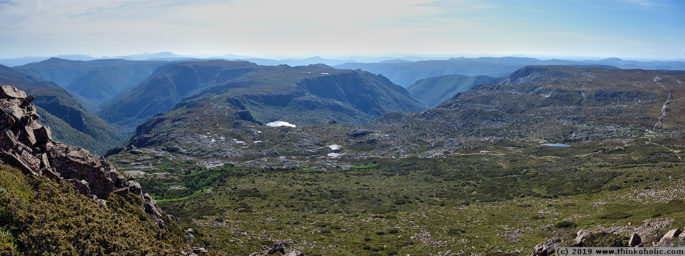the overland track is a 78 km multi-day hike through the tasmanian wilderness. it is also one of the best outdoor adventures we have ever been on.
if you’re preparing to walk the overland track, here are some first-hand recommendations that you might find helpful:
plan your meals
consider what you eat on a long single-day hike and work from there. choose longlife, dehydrated and/or high-energy food (i.e. more calories, less weight) whenever possible.
when not specified, the amounts given below were for two adults and 8 days.
breakfast: we brought instant porridge for breakfast (1.5 sachets/servings per person and day). just add hot water (and powdered milk for taste), stir, and it’s ready to go.
for lunch, we made sandwiches from bread (1 loaf of fresh bread for the first days, then 1 pack each of pumpernickel and wraps), 240 g of hard cheese, mustard, and 120g of (initially) fresh spinach to treat ourselves (other hikers were definitely jealous!).
toward the end of the hike, we switched to peanut butter and/or nutella on bread. or sometimes even just a spoonful of either spread as a snack or dessert.
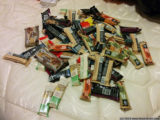 snacks: to keep us going through the day, we brought 400 g dry fruit & nuts, and 3 muesli bars per person per day (+an emergency muesli bar buffer). we used up most of that along the hike, with only 16 out of 60 muesli bars left (i.e. 8 emergency muesli bars per person) at the end.
snacks: to keep us going through the day, we brought 400 g dry fruit & nuts, and 3 muesli bars per person per day (+an emergency muesli bar buffer). we used up most of that along the hike, with only 16 out of 60 muesli bars left (i.e. 8 emergency muesli bars per person) at the end.
dinner was our main, sit-down meal of the day (after setting up camp). see next paragraph for details.
dehydrate your own meals.
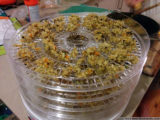 we brought two commercial freeze-dryed meals (made by “back country cuisine”) as a christmas treat, but found that they didn’t taste that great, servings were rather small, and the meals were definitely very expensive for what you get. for all other dinners, we bought a food dehydrator for ~30 AUD, and just cooked a second dinner every other evening in the weeks leading up to our hike: one to eat as usual, and one to dehydrate for fast rehydration/reheating on the hike.
we brought two commercial freeze-dryed meals (made by “back country cuisine”) as a christmas treat, but found that they didn’t taste that great, servings were rather small, and the meals were definitely very expensive for what you get. for all other dinners, we bought a food dehydrator for ~30 AUD, and just cooked a second dinner every other evening in the weeks leading up to our hike: one to eat as usual, and one to dehydrate for fast rehydration/reheating on the hike.
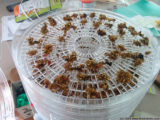 for serving size, we went for a generous dinner (1-1.3 times of a normal serving).
for serving size, we went for a generous dinner (1-1.3 times of a normal serving).
our meals consisted of fried/cooked vegetables with either instant noodles, cous cous, or as a risotto. some cheese in sauces was ok (= turned into yummy, lumpy rehydrated cheese bits), but we avoided meat due to the lack of refrigeration.
cutlery & crockery
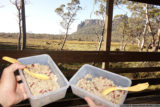 instead of plates or bowls, we chose “clip lock” plastic food containers of 1 liter capacity each. make sure they’re microwave-safe (i.e. you can add boiling water) and have a silicone-sealed lid, so you can safely carry wet food or hot water during the day, if needed. we used the containers as bowls for larger, hot meals, and the lids worked as sandwich plates whenever needed.
instead of plates or bowls, we chose “clip lock” plastic food containers of 1 liter capacity each. make sure they’re microwave-safe (i.e. you can add boiling water) and have a silicone-sealed lid, so you can safely carry wet food or hot water during the day, if needed. we used the containers as bowls for larger, hot meals, and the lids worked as sandwich plates whenever needed.
despite our initial mistrust, the original spork by light my fire turned out to be awesome! while the knife’s value is limited (our swiss army knife came in very handy), the lightweight spoon/fork combination was versatile and fantastic to have!
you don’t need that many clothes!
clothing is one of the things we seriously overpacked. limit the number of items you bring, and then throw out some of that again. you need to carry everything on your back for more than a week, and things add up quickly.
your standards will probably adjust to the available options (as they usually do in the outdoors), and you can also hand-wash things like underwear if needed. in terms of overkill, we each brought 6 t-shirts, 10 underpants, 8 pairs of socks for 8 days, but could have easily done with less.
in one of the huts, we overheard a teenage boy asking his parents if he had a second pair of socks. his parents just responded with laughter.
expect cold, wet weather
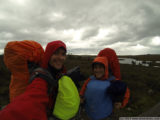 our adventure started on the same day as a 10-year heat record in the tasmanian summer. naturally, we hated the national parks team for insisting on 4 kg winter sleeping bags. a few days later, temperatures had dropped to as low as 5 degrees, and we were very happy to have our winter hats, gloves, thermal pants, and winter sleeping bags.
our adventure started on the same day as a 10-year heat record in the tasmanian summer. naturally, we hated the national parks team for insisting on 4 kg winter sleeping bags. a few days later, temperatures had dropped to as low as 5 degrees, and we were very happy to have our winter hats, gloves, thermal pants, and winter sleeping bags.
we would also have been happy to have truly waterproof pants, had we not thought “it’ll be fine” instead.
when it really rains, it helps to have some large heavy-duty garbage bags for emergency waterproofing and compartmentalizing inside your backpack.
bring baby wipes
it may not seem like much, but when you’re out adventuring with no access to showers, and even your swimming options are limited, anti-bacterial baby wipes are an effective, compact, and low-weight option to retain some level of personal hygiene at the end of a long hiking day.
they dry up quickly after use, and add little to your waste bag. remember that even biodegradable soap and detergents should never be used close to freshwater streams or lakes, as they are toxic to many aquatic organisms.
consider sleeping in
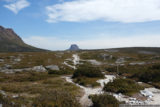 during the summer months, the park’s office is limiting entrance to the track to 34 walkers per each day. the limit is pretty effective in preserving the wilderness atmosphere, but our late mornings reinforced that several times more: we usually slept in, and started walking around 11:00, several hours after all others had already left. the amazing result of that was that we hardly ever saw other hikers outside of the camps, and had the tasmanian wilderness almost to ourselves.
during the summer months, the park’s office is limiting entrance to the track to 34 walkers per each day. the limit is pretty effective in preserving the wilderness atmosphere, but our late mornings reinforced that several times more: we usually slept in, and started walking around 11:00, several hours after all others had already left. the amazing result of that was that we hardly ever saw other hikers outside of the camps, and had the tasmanian wilderness almost to ourselves.
